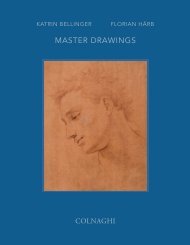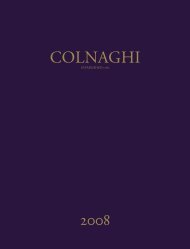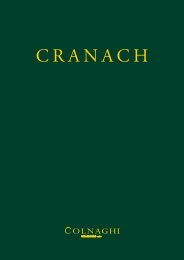2007 Catalogue - Colnaghi
2007 Catalogue - Colnaghi
2007 Catalogue - Colnaghi
Create successful ePaper yourself
Turn your PDF publications into a flip-book with our unique Google optimized e-Paper software.
Provenance: Cardinal Joseph Fesch, by whom<br />
acquired from the artist in 1802, for 6000 francs (see<br />
J.B. Vanel, ‘Deux livres de comptes du cardinal Fesch’,<br />
Bulletin historique du diocèse de Lyon, January 1929,<br />
p. 76, no. 1); (†) sale, Rome, 26 March 1844 ff., lot<br />
820; Private collection, Portugal.<br />
Exhibited: Paris, Salon, 1799, no. 280 (‘Un tableau<br />
représentant la Tarentelle, danse napolitaine. Larg.<br />
2m., haut. 1m 30 c.’).<br />
Literature: Salon, ‘Arlequin au Muséum ou les<br />
Tableaux en vaudeville’, Coll. Deloynes, 1799, XXI, pp.<br />
109-110, no. 561; ‘La Revue du Muséum’, Coll.<br />
Deloynes, 1799, XXI, p. 159, no. 562; ‘Exposition de<br />
tableaux au Salon du Louvre. Journal d'indications’,<br />
Coll. Deloynes, 1799, XXI, pp. 361-362, no. 579;<br />
‘Exposition des ouvrages de peinture...insérée dans le<br />
Journal de la Décade par le C.Chaussard’, Coll.<br />
Deloynes, 1799, XXI, pp. 455-456, no. 580; 25<br />
fructidor/11 septembre, 1799, Journal des Arts, de<br />
littérature et de commerce, p. 2, no. 11; J.B. Vanel,<br />
‘Deux livres de comptes du cardinal Fesch, archevêque<br />
de Lyon’, Bulletin historique du diocèse de Lyon, 1802,<br />
January 1923, p. 76, no. 1 ('la Tarentelle de Sablet<br />
6.000 fr.'); 7 vendémiaire/30 septembre, 1803, Arch.<br />
nat., Minutier central, Etude LXIX, 870, Inventaire J.<br />
Sablet, 23 fructidor an XI/10 September, folio 19<br />
(tableau appartenant à Lucien Bonaparte, ‘La<br />
Tarentaine’); Fiorillo, Geschichte der Künste..., 1805, II,<br />
p. 520; (George), <strong>Catalogue</strong> des tableaux composant la<br />
Galerie de feu son éminence le cardinal Fesch, 1841,<br />
Rome, no. 1751 ('Une fête de matelots'); 26 mars ff,<br />
Rome, vente du cardinal Fesch, 1844, no. 820 ('Une<br />
fête napolitaine'); A. van de Sandt, Jacques Sablet<br />
(1749-1803). Biographie et catalogue raisonné,<br />
Université de Paris IV - Sorbonne, 1983, no. X. 29, as<br />
‘localisation inconnue’.<br />
23<br />
Jacques Sablet<br />
(Morges 1749 – 1803 Paris)<br />
La Tarantelle: An evening coastal Landscape<br />
with Neapolitan Peasants dancing the Tarantella<br />
With indistinct traces of a signature centre left: SABL<br />
and an inventory number ‘No 665.d.C.’ (painted in black on the reverse)<br />
Oil on canvas<br />
61 x 83 1 /2 in. (154.9 x 212.1 cm.)<br />
70<br />
The whereabouts of this magnificent picture was<br />
unknown for over 150 years until its recent rediscovery<br />
in a private collection in Portugal. Exhibited to much<br />
acclaim in the 1799 Paris Salon, the work was last seen<br />
in the collection of Cardinal Joseph Fesch whence it<br />
was sold in 1844. Anne van de Sandt, who, in her<br />
1983 catalogue raisonné, describes the painting as<br />
“certainement l’un des chefs-d'oeuvre de Jacques<br />
Sablet”, 1 has confirmed the attribution on the basis of<br />
colour transparencies and has kindly provided<br />
information for the following catalogue note. 2<br />
This monumental work depicts an idyllic scene of<br />
Neapolitan peasants dancing the Tarantella before a<br />
harbour with a castle reminiscent of the Castel Nuovo,<br />
Naples, to the left and the fortress of Gaeta beyond. 3<br />
The Tarantella was a lively dance, performed to the<br />
accompaniment of tambourines, a guitar, or<br />
sometimes, as here, a lute. It is commonly believed to<br />
be named after the tarantula spider which was<br />
(incorrectly) thought to cause tarantism, a form of<br />
hysteria that was at one time endemic to the southern<br />
Italian town of Taranto, and the cure for which was<br />
thought to involve wild dancing. The same dance is<br />
surely being performed in Sablet's Danse Napolitaine,<br />
(99 x 137 cm.), commissioned by Gustav III of<br />
Sweden in 1784 (now in Drottningholm Castle,<br />
Sweden). From this composition the three main groups<br />
of musicians to the right the dancing couple in the<br />
centre, and the drinking couple to the left, have clearly<br />
evolved and can be found in the present work.








